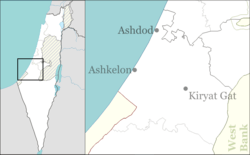Neve Mivtah
| Neve Mivtah | |
|---|---|
 Neve Mivtah | |
| Coordinates: 31°48′19.08″N 34°44′27.6″E / 31.8053000°N 34.741000°ECoordinates: 31°48′19.08″N 34°44′27.6″E / 31.8053000°N 34.741000°E | |
| District | Southern |
| Council | Be'er Tuvia |
| Affiliation | Moshavim Movement |
| Founded | 1950 |
| Founded by | Polish immigrants |
| Population (2017)[1] | 666 |
Neve Mivtah (Hebrew: נְוֵה מִבְטַח, lit. Oasis of Confidence) is a small moshav in southern Israel. Located near Bnei Ayish and Gedera, it falls under the jurisdiction of Be'er Tuvia Regional Council. In 2017 it had a population of 666.[1]
Etymology
The moshav is surrounded by military bases, such as Hatzor Airbase and Tel Nof Airbase. Because of this, a feeling of security and confidence was over the founders, and the moshav was given its name meaning "Oasis of Confidence". The inspiration for the name came from the Book of Psalms:
" 'O God of our salvation; the confidence (=mivtah) of all the ends of the earth' (Psalms 65:6)"[2][3]
History
The moshav was founded in 1950, partially on land that had belonged to the depopulated Palestinian village Bashit,[4] and nowadays is inhabited by about 120 families. [5] At first it was a temporary ma'abara to sixty immigrant families of Holocaust survivors from Poland,[4] serving as an expansion to the older moshav Bitzaron. Its residents were housed in tin dwellings, supplied by the Jewish Agency for Israel. Since it was not an independent moshav, the future residents had to redeem the food coupons, supplied by the Agency, at Bitzaron centre. The residents of Bitzaron were given favour as to the food supply, and thus many times had the inhabitants of the ma'abara to return empty-handed. They have decided to cut themselves off from Bitzaron, and on 1950, only a short while after placing the ma'abara, Neve Mivtah was founded.
References
- 1 2 "List of localities, in Alphabetical order" (PDF). Israel Central Bureau of Statistics. Retrieved August 26, 2018.
- ↑ Place Names in Israel. A Compendium of Place Names in Israel compiled from various sources. Translated from Hebrew, Jerusalem 1962 (Israel Prime Minister’s Office. The Israeli Program for Scientific Translations) p.218
- ↑ Bitan, Hanna: 1948-1998: Fifty Years of 'Hityashvut': Atlas of Names of Settlements in Israel, Jerusalem 1999, Carta, p.46, ISBN 965-220-423-4 (in Hebrew)
- 1 2 Mapa's concise gazetteer of Israel (in Hebrew). Yuval El'azari (ed.). Tel-Aviv: Mapa Publishing. 2005. p. 361. ISBN 965-7184-34-7.
- ↑ Khalidi, Walid (1992). All That Remains: The Palestinian Villages Occupied and Depopulated by Israel in 1948. Washington D.C.: Institute for Palestine Studies. p. 363. ISBN 0-88728-224-5.